North Carolina’s unique range of habitats and climates gives it a huge amount of species diversity, especially when it comes to the state’s resident reptiles! Around a dozen or so different lizards reside in the Tar Heel State, most of which are long, slender skinks and bizarre legless lizards. Below, we’ll take an in-depth look at 10 of the most incredible lizards living in North Carolina!

1. Common Five-Lined Skink (Plestiodon fasciatus)
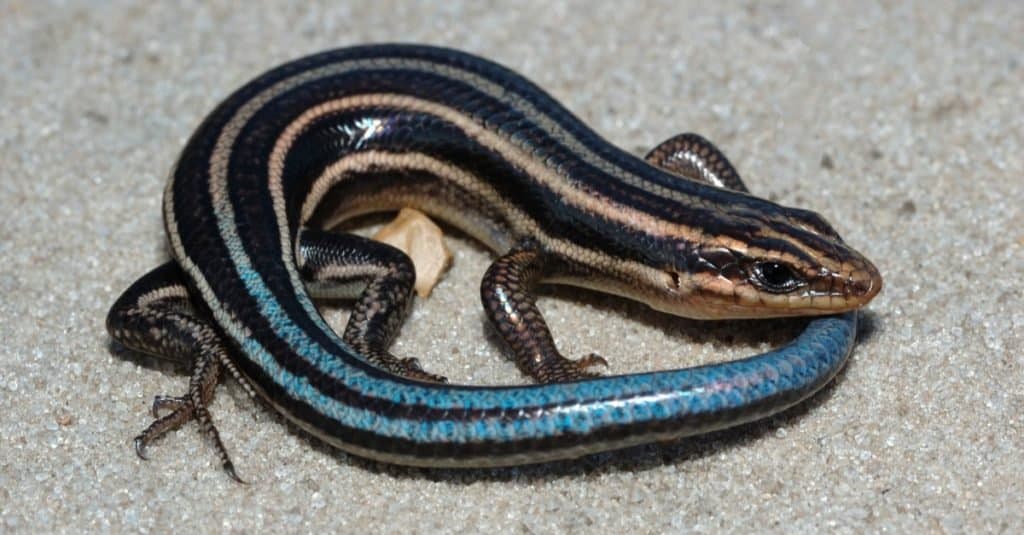
This juvenile five-lined skink’s blue tail will fade as it ages.
©James DeBoer/Shutterstock.com
The common five-lined skink is one of North America’s most common and widespread native lizard species! Its vast geographic range covers all of North Carolina as well as most of the eastern half of the United States. This little reptile is even hardy enough to withstand southern Canada’s chilly climate! Its preferred habitats are densely wooded forests with soft, moist soil near bodies of water.
If you’ve ever spotted one of these lizards in the wild, you probably stumbled upon a hatchling or juvenile skink — their bright blue tails are instantly recognizable even at a distance. As they age, however, their dark brown bodies and blue tails fade to a more uniform, drab brown color. Both juveniles and adults have, as their name suggests, five thin yellow lines extending vertically down their bodies from head to tail.
When fully grown, most common five-lined skinks reach roughly 5 to 8 inches long from snout to tail tip. The species is slightly sexually dimorphic, as males are typically larger than females.
2. Eastern Fence Lizard (Sceloporus undulatus)
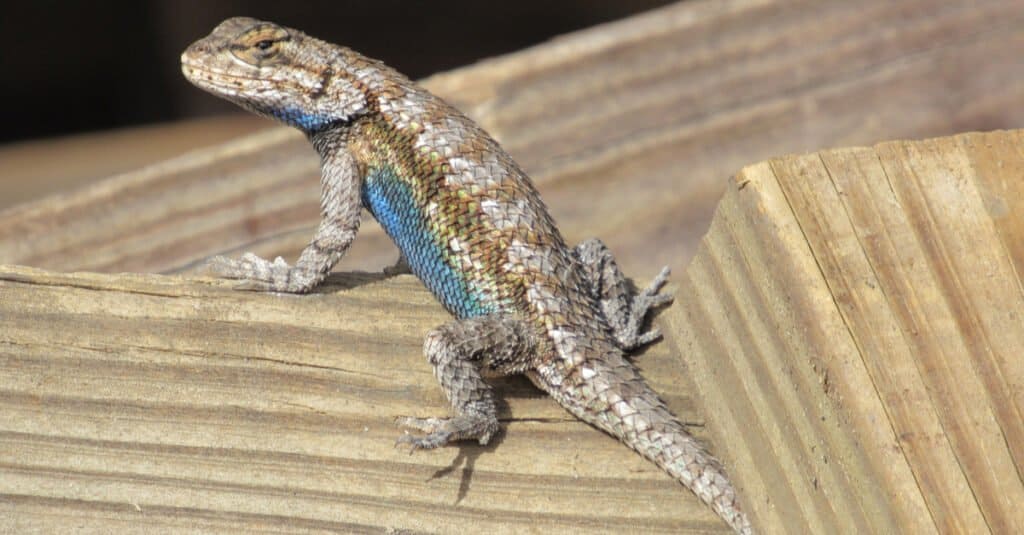
Male eastern fence lizards are easily identified by their blue bellies.
©Isabel Eve/Shutterstock.com
The eastern fence lizard is another very common and widespread species throughout North Carolina and much of the eastern United States. It has two current subspecies and a variety of common names, including the prairie lizard and the pine lizard. Its two subspecies are similar in appearance and size and mainly differ slightly by geographic range.
Mostly solid gray or brown, the typical eastern fence lizard is covered in keeled scales that point slightly outward from its body, giving it a rough, textured appearance. Its snout is short and pointed. Fully-grown adults usually reach 4 to 7 inches in length from snout to tail tip.
Notably, the species is sexually dichromatic, as males have bright blue splotches on their bellies. Females can sometimes also develop these blue spots, but they are far less vibrant by comparison.
3. Mimic Glass Lizard (Ophisaurus mimicus)
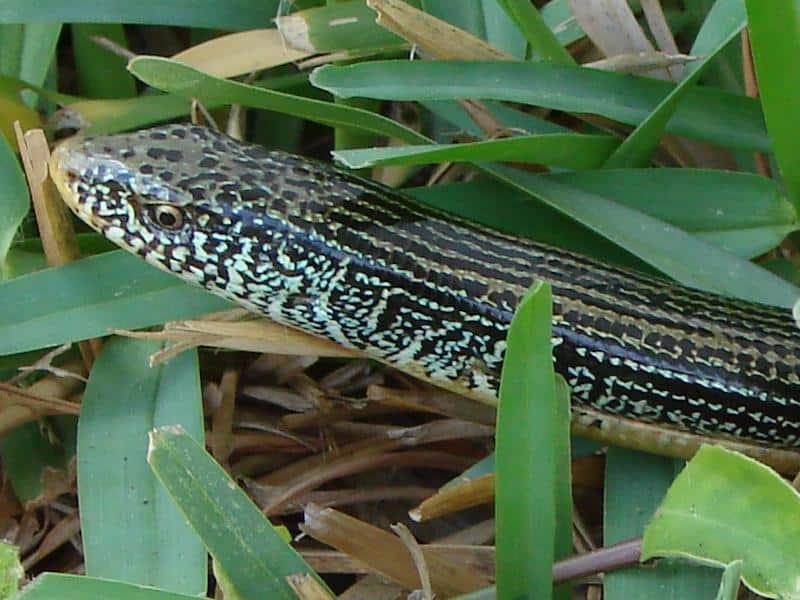
Mimic glass lizards spend much of their time digging around in moist soil and leaf litter.
©Fl295, Public domain, via Wikimedia Commons – License
Also sometimes known as the rainbow glass lizard, the mimic glass lizard is a bizarre reptile that, at a glance, looks somewhat like a garter snake. Despite its confusing appearance, it is a legless lizard! It can be easily differentiated from snakes by its movable eyelids, narrow, inflexible jaws, and visible external earholes–three key traits snakes, lack.
At around 15 to 25 inches long from snout to tail tip, mimic glass lizards are quite long and slender. They are typically brown or dark green, with several narrow yellow or white stripes stretching vertically along the sides of the body. Small, irregular yellow or white spots throughout the head and body are also common.
The mimic glass lizard is native to North Carolina’s eastern coast and much of the southeastern United States coastal regions. Its preferred habitats are coastal pinewood forests with soft, sandy soil ideal for burrowing. Because it is not an agile climber, it is terrestrial and semi-fossorial.
4. Texas Horned Lizard (Phrynosoma cornutum)
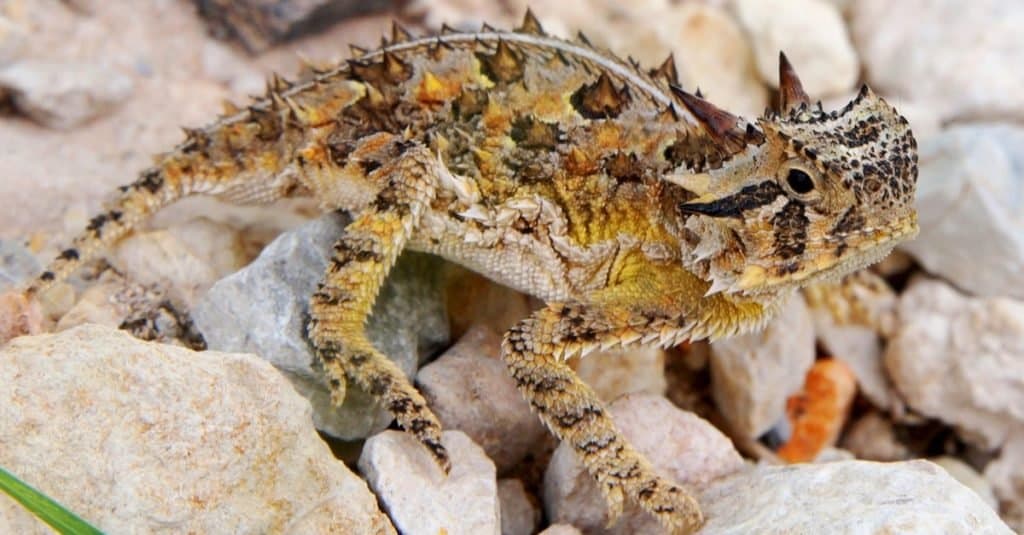
The Texas horned lizard’s body is covered in pointed spines.
©Matt Jeppson/Shutterstock.com
One of North Carolina’s most unusual lizards, the Texas horned lizard, is a bit far from its native home. While it normally lives in much hotter, drier regions, it is believed to have been introduced to the Tar Heel state via the exotic pet trade. Currently, its populations are small and scattered along North Carolina’s southeastern coast.
At a mere 2.5 to 4 inches long, the Texas horned lizard is small, squat, and round. Its body is covered in short, pointed spines, and its scales are heavily keeled. A crown of larger pointed spines protrudes from the back of its head. Its coloration is mainly light tan with mottled darker brown and beige spots. Two thin, parallel rows of pointed spines also stretch along the sides of its belly.
Since it fares best in hot and dry habitats, this pudgy little lizard tends to seek out similar habitats in North Carolina. Here, it typically resides in flat, sandy areas–but it’s never too far from a body of water.
Like most other horned lizard species, the Texas variety can squirt bitter-tasting blood from its eyes as a defense mechanism. However, it will usually simply flee or burrow itself in nearby sand if startled.
5. Green Anole (Anolis carolinensis)
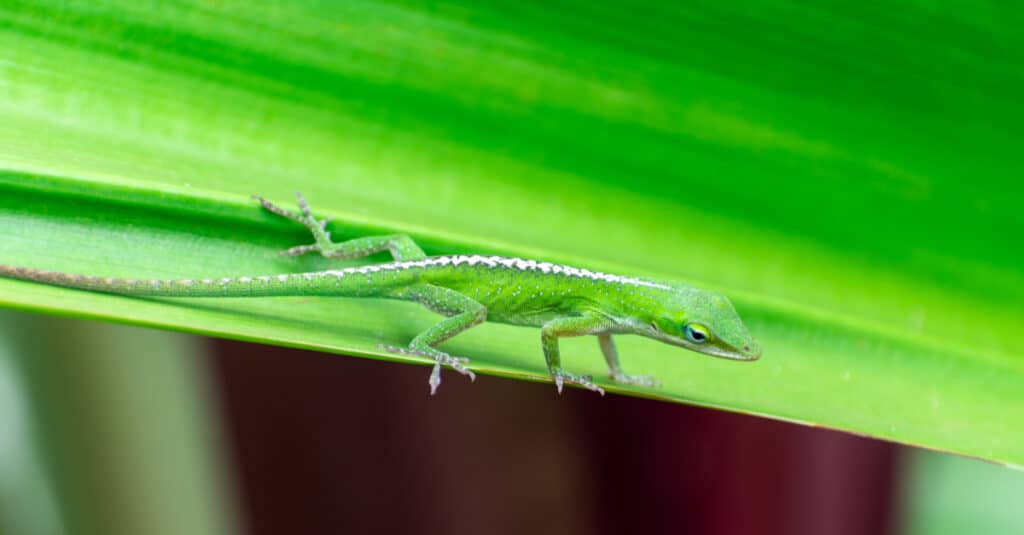
Green anoles blend in with their lush, green surroundings exceptionally well.
©Raphael Rivest/Shutterstock.com
Yet another extremely common reptile that has colonized much of the eastern United States is this vibrant little green lizard. These highly arboreal lizards are skilled climbers and extremely fast-moving. Because of this, despite how common they are, it can be difficult to observe them up close or handle them.
At around 4 to 8 inches long from snout to tail tip, the green anole is a small and slender lizard. Its snout is long and triangular, and its tail makes up much of its total body length. The species is sexually dimorphic, as males are slightly larger than females on average. Additionally, the male green anole has a far larger and more brightly-colored dewlap under its chin.
Due to its arboreal nature, it prefers densely forested habitats with lots of trees, vines, shrubs, and other plant life for climbing. These lush, green habitats also provide the lizard with the perfect camouflage from its many predators, such as snakes, birds, and frogs.
6. Slender Glass Lizard (Ophisaurus attenuatus)
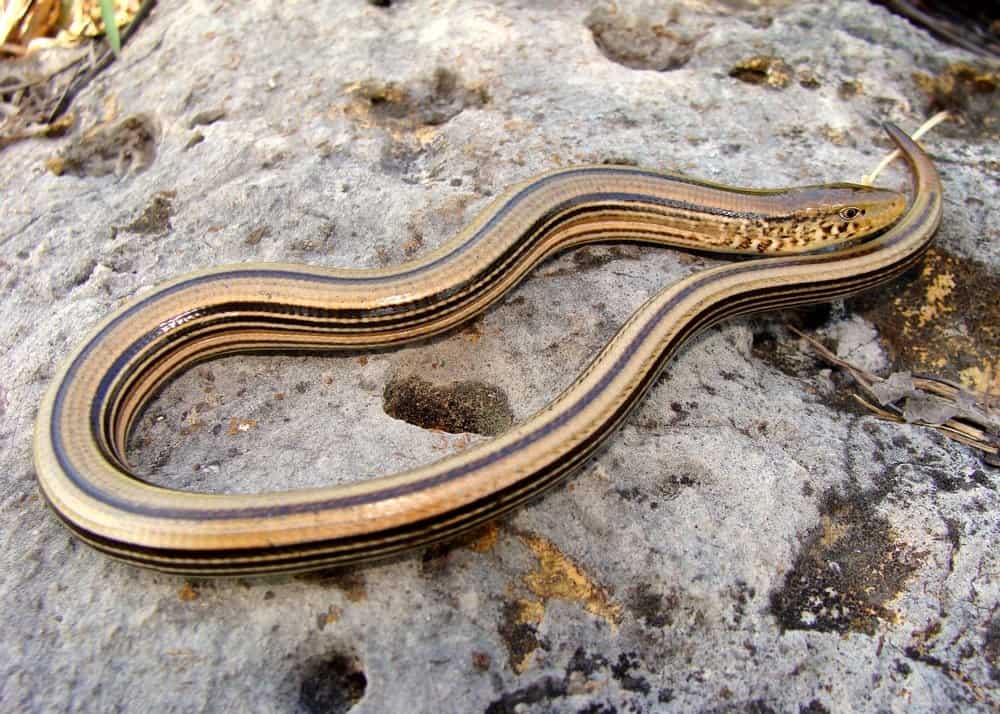
Slender glass lizards have long, thin stripes running down the length of their bodies.
©Matt Jeppson/Shutterstock.com
We now come to another bizarre yet fascinating legless lizard: the slender glass lizard! Currently, there are two subspecies, the eastern and western varieties. These subspecies mainly differ by their geographic range and preferred habitat. Like other glass lizards, both varieties are capable of breaking off parts of their own tail as a defense mechanism.
The slender glass lizard is, like its name implies, long and slender. As one of the largest known glass lizards, it is capable of reaching anywhere from 20 to 35 inches in length. Its body is typically brown or tan. Six thin, alternating darker brown and white stripes run vertically along the sides of its body, in addition to a lighter gray stripe running down the top of its back.
This species is native to much of North Carolina, as well as the majority of the Southeastern United States and the Midwest. It is hardy and able to thrive in a variety of habitats, but it prefers sparsely wooded prairies and forests near bodies of water.
7. Coal Skink (Plestiodon anthricinus)

The coal skink is common throughout eastern North Carolina.
©Hunter Kauffman/Shutterstock.com
The coal skink currently is divided into two subspecies: the northern and southern varieties. These species mostly differ by geographic range. The northern coal skink resides in the northern half of the United States, while the southern variety mainly occupies the Southeast and Midwest regions. Interestingly, both subspecies of this lizard can be found in eastern North Carolina.
The typical coal skink is roughly 5 to 7 inches long from snout to tail tip. Like most skinks, its tail is very long and narrow and makes up much of its total body length. It is typically dark brown with four thin light yellow or white lines stretching from the base of its neck down to its tail. As juveniles, coal skinks have bright blue tails, which fade gradually with age.
Notably, this species displays slight sexual dichromatism. The male coal skink often develops orange or red coloring around its head and neck during the species’ breeding season.
8. Eastern Glass Lizard (Ophisaurus ventralis)

Though it looks like a snake, the eastern glass lizard has movable eyelids and external ear holes — traits that snakes lack.
©iStock.com/Dan Rieck
The third main glass lizard species living in North Carolina is the eastern glass lizard. While its native range stretches across much of the Southeast United States, it occupies only a small portion of North Carolina’s southeastern coast. It prefers living in moist, sandy habitats near bodies of water like wetlands and pine flatwoods.
In terms of size, adult eastern glass lizards vary significantly, from around 18 to 43 inches in length. This could be because many wild glass lizards often drop portions of their tails defensively when escaping predators and will therefore differ in length.
Most individuals are mostly dark brown or dark green in color with very small mottled white, yellow, and tan speckles or dots across the top and sides of the body. The underside is solid yellow or off-white. Juvenile eastern glass lizards are a lighter greenish-brown color with less distinct markings. Currently, there are no subspecies.
9. Ground Skink (Scincella lateralis)
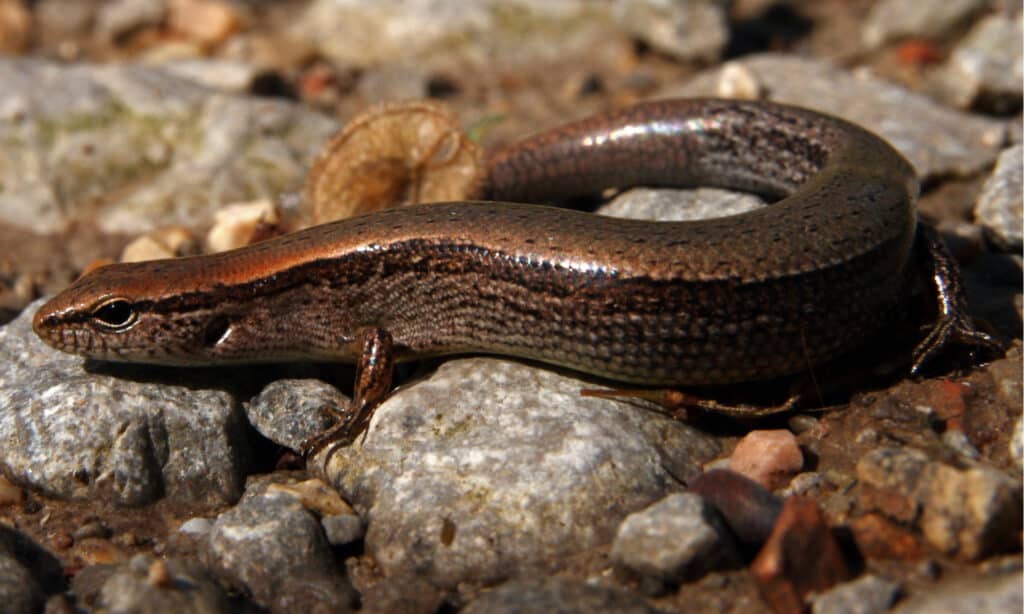
The ground skink is one of North America’s smallest native reptiles.
©Ryan M. Bolton/Shutterstock.com
If you can’t already tell, North Carolina’s most common lizards by far are skinks and glass lizards! At a mere 3 to 5 inches long, the ground skink is actually one of the smallest reptiles native to the United States. It has picked up a few different common names, most notably the “little brown skink” due to its tiny size and uniform brown coloration.
Despite its diminutive nature, the ground skink has managed to establish a huge geographic range! It lives throughout much of the Southeastern U.S. and even parts of the Midwest, all the way from Oklahoma, Kansas, and Texas to Florida and the Carolinas on the east coast. It is also quite hardy and adaptable, so it can thrive in various habitats.
As a terrestrial and fossorial species, the ground skink stays low to the ground. It isn’t much of a climber, but it is able to burrow and easily camouflage itself amongst soil and leaf litter to evade its many predators and hunt its insect and invertebrate prey.
10. Broad-Headed Skink (Plestiodon laticeps)
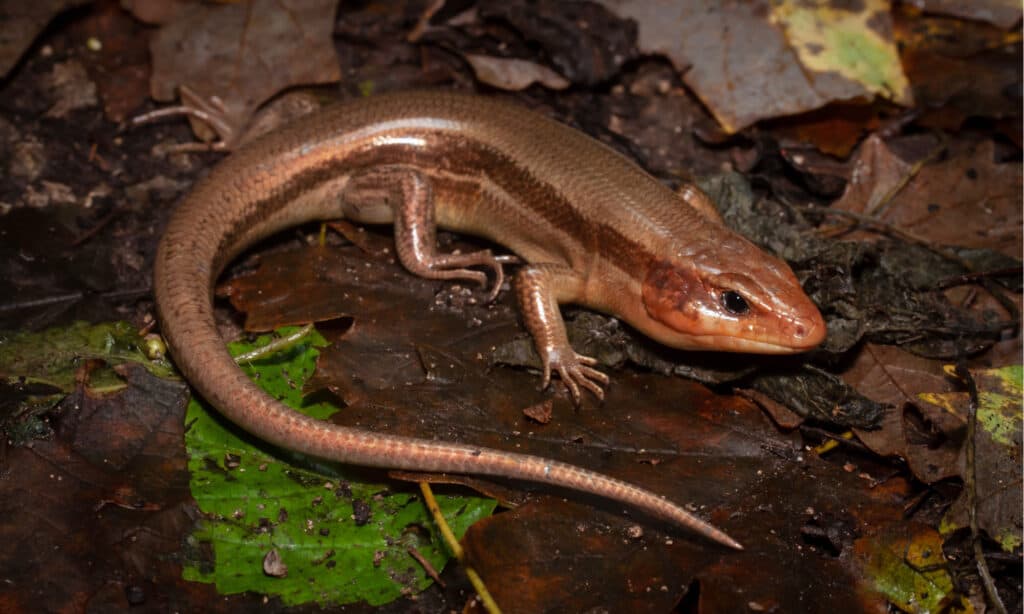
Unlike most other skink species, broadhead skinks are comparatively short and stout.
©Mike Wilhelm/Shutterstock.com
Also interchangeably known as the broadhead skink, this stout, robust lizard is one of the world’s largest skinks from the Plestiodon genus! In addition to being fairly wide-bodied for a skink, it is quite long, often reaching 6 to 12 inches from snout to tail tip. True to the lizard’s common name, its head is wide and triangular.
The typical broad-headed skink is primarily brown, copper, or greenish-brown in color with a tan or light yellow underside. It is slightly sexually dichromatic, as males develop a bright orange or red coloration on their heads during the species’ breeding season. Additionally, females have five thin, light white or yellow stripes stretching vertically down their backs and tails. Juvenile broad-headed skinks have bright blue tails which fade with age.
This particular skink species is actually semi-arboreal, so it is a fairly skilled climber and reasonably fast on land as well. It inhabits much of North Carolina (as well as the Southeastern U.S. in general). Its preferred habitats are dense forests where it can live and nest in hollowed-out trees.
Summary of 10 Fascinating Lizards in North Carolina
Here’s a recap of the 10 interesting lizards we looked at that are present in North Carolina.
| Number | Lizard | Scientific Name | Range | Length (Snout to Tail Tip) |
|---|---|---|---|---|
| 1 | Common Five-Lined Skink | Plestiodon fasciatus | All of North Carolina and most of the eastern half of the U.S. | 5-8 inches |
| 2 | Eastern Fence Lizard | Sceloporus undulatus | Throughout North Carolina and much of the eastern U.S. | 4-7 inches |
| 3 | Mimic Glass Lizard | Ophisaurus mimicus | Native to North Carolina’s eastern coast and much of southeastern U.S.’s coastal regions | 15-25 inches |
| 4 | Texas Horned Lizard | Phrynosoma cornutum | Populations are small and scattered along North Carolina’s southeastern coast | 2.5-4 inches |
| 5 | Green Anole | Anolis carolinensis | Much of the eastern U.S. | 4-8 inches |
| 6 | Slender Glass Lizard | Ophisaurus attenuatus | Native to much of North Carolina and majority of the southeastern U.S. and the midwest | 20-35 inches |
| 7 | Coal Skink | Plestiodon anthricinus | Northern and southern coal skinks found in eastern North Carolina | 5-7 inches |
| 8 | Eastern Glass Lizard | Ophisaurus ventralis | In a small part of North Carolina’s southeastern coast and much of the southeast U.S. | 18-43 inches |
| 9 | Ground Skink | Scincella lateralis | Much of the southeastern U.S., parts of the Midwest from Oklahoma, Kansas, and Texas to Florida and the Carolinas | 3-5 inches |
| 10 | Broad-Headed Skink | Plestiodon laticeps | Much of North Carolina and southeastern U.S. | 6-12 inches |
The photo featured at the top of this post is © Mike Wilhelm/Shutterstock.com
Thank you for reading! Have some feedback for us? Contact the AZ Animals editorial team.







